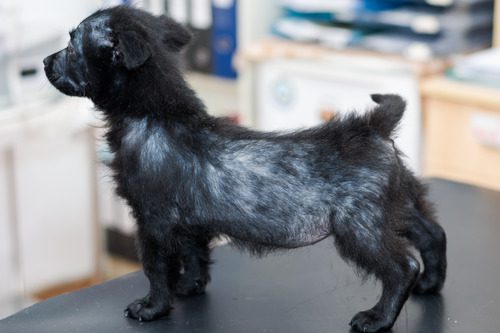Understanding Dog Hip Dysplasia
Dog hip dysplasia is a prevalent condition in dogs, but it can also occur to a lesser extent in cats. Hip dysplasia often leads to discomfort and reduced mobility in our canine patients, which impacts their quality of life and puts them at risk for other health complications. At Best Friends Veterinary Hospital in Crossville, TN, we’re dedicated to helping pet owners understand this condition and providing the best care for their dogs.
If you’re concerned about your dog’s health and mobility, be sure to call us at (931) 459-2006 for an appointment or more information.

What is Dog Hip Dysplasia?
At its core, canine hip dysplasia is a joint disorder that results in the improper development and fit of the hip joint, which leads to a range of mobility issues and pain for the dog experiencing it. It’s a complex condition that can be influenced by multiple factors. While genetics and abnormal development can play a significant role, it’s important to understand that hip dysplasia is not always genetically inherited and can be caused by a combination of factors, including acute injury, obesity, rapid growth, and poor nutrition.
Awareness of these factors can aid significantly in the early detection and intervention of this condition.
Clinical Signs of Hip Dysplasia in Dogs
Recognizing the signs of hip dysplasia is the first step toward successful treatment.
Common symptoms of hip dysplasia include:
- Limping or lameness; noticeable discomfort while walking.
- Difficulty standing up or jumping, slow to lie down
- Audible noise from hips, such as clicking sounds during movement.
- Reduced activity levels; less enthusiasm for play or exercise.
- Changes in gait (an altered way of walking, sometimes seen as “bunny hopping”).
Each of these signs indicates possible joint discomfort and warrants veterinary attention as soon as possible.
Diagnosing Dog Hip Dysplasia
If we suspect hip dysplasia in your dog, we will need to thoroughly examine them to check their joints and rule out other problems. At home before your pet’s appointment, it would be beneficial for you to film your dog in motion so you can show your veterinarian and give them better insight into your pet’s condition.
Diagnosing hip dysplasia generally involves the following:
- Physical Examination: Assessing your dog’s mobility and pain response.
- X-rays: Visualizing your dog’s hip joint structure in detail.
- Other Imaging Techniques: If needed, we can recommend your pet for an MRI or CT scan with a veterinary radiologist.
These diagnostic tools are invaluable for determining the severity of canine hip dysplasia and guiding an effective, custom treatment for the patient.
How Can Dog Hip Dysplasia Be Treated?
Depending on your dog’s age, physical condition, and the extent of their hip pain or lameness, there are several surgical options available:
Triple Pelvic Osteotomy (TPO)
TPO surgery may be suitable for young dogs (6-12 months old) with no evidence of osteoarthritis. TPO corrects laxity within the hip joint, maintaining the dog’s natural joint while eliminating pain and lameness.
Total Hip Replacement (THR)
THR is ideal for dogs over 12 months old with osteoarthritis or hip dislocation due to severe dysplasia. THR involves replacing the affected joint with a prosthetic one, mimicking the biomechanics of the original joint. This surgery has a high rate of success, restoring the patient’s normal motion and gait, and allowing active dogs to resume high activity levels.
Femoral Head Ostectomy (FHO)
The FHO procedure involves removing the painful hip joint, allowing a “false” joint of scar tissue to develop. This procedure may be suitable for dogs with pain from hip dysplasia where a total hip replacement isn’t an option, due to higher risk or other factors. FHO reduces pain but may result in an abnormal gait.
Are There Non-Surgical Treatment Options for Dog Dysplasia?
Conservative treatment may be recommended to help manage your dog’s hip dysplasia symptoms. Treatment options might include joint supplements, pain medications, a weight management plan, and/or physical rehabilitation. However, while these methods may improve your dog’s comfort, they are not a cure for arthritis caused by hip dysplasia, and eventually, surgical intervention may be required to improve your dog’s quality of life.
Ultimately, our goal is to help you help your dog in any way possible so they can live a healthy, pain-free life. There are many options available to relieve the pain caused by arthritis and hip dysplasia, and there may also be preventative measures you can take if your pet is young but at risk of developing hip dysplasia when they get older.
Talk to Your Vet About Dog Hip Dysplasia
Your veterinarian can give you the best advice regarding your dog’s needs. If they are showing any signs of discomfort, including difficulty walking, changes in behavior (such as increased irritability or withdrawal), or eating less, contact Best Friends Veterinary Hospital in Crossville, TN at (931) 459-2006. Remember, early intervention can make a significant difference in your pet’s treatment. Our team can perform a thorough evaluation, answer all your questions, and discuss the best course of action for your pet’s comfort and well-being.
Recent Posts
About Best Friends Veterinary Hospital
Our veterinarians and staff warmly welcome dogs, cats, and a variety of exotic pets as patients here at our animal hospital, and we offer a host of services to give your unique family member a lifetime of excellent care.





